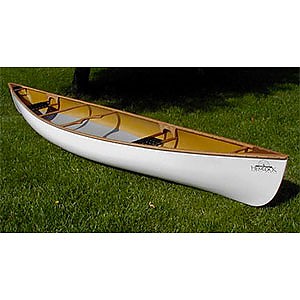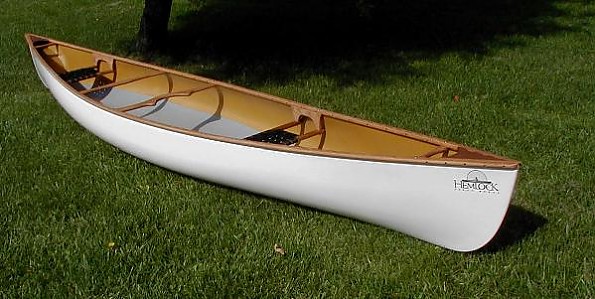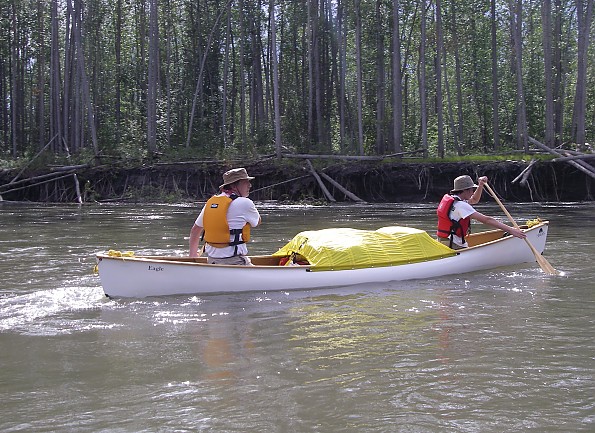Hemlock Eagle

If you are looking for a quality tandem canoe with moderate rocker and light weight, the Eagle might just be for you. One advantage is the narrow gunnel width at the bow paddling station which is good for smaller paddlers.
Pros
- Fast for its type
- Lightweight
- High quality build
- Solid lay up
- Stiff
- Can be paddled tandem or solo
- Narrow bow paddler station
Cons
- High price
- Capacity limited for long expeditions
- Fine ends limit white water use to Class 2 when heavily laden
- Shouldered tumblehome can cause some instability when leaned to an extreme
Background
Dave Curtis has been building canoes for almost four decades. His first design was a solo boat. He wanted a solo tripping canoe that could stay with tandems on remote river and lake trips. His first designs were drawn by legendary paddler Harold Deal. They pioneered the use of shouldered tumblehome to give a canoe a narrow gunnel at the paddling station for a more vertical stroke, but a wider hull for stability and stiffness.
Later, David Yost participated in designing the boats that Curtis built. Curtis Canoes was sold in 1987, but Dave Curtis couldn’t stay away from canoe building, and so formed Hemlock Canoe Works, in the same village of Hemlock, New York where he had operated Curtis Canoes.
Today, Dave and his wife Carol continue to build fine quality canoes that provide good strength to weight ratios. Their laminate schedules incorporate no foam core or supplemental stiffeners, just high quality fabrics. They use vinylester resins for that resin’s superior bonding to kevlar, carbon fiber and spectra.
Although most of their canoes are solos, Hemlock Canoe Works builds the Eagle, a tandem tripping canoe that is 16' 5" long.
Initial Impression
At first look, the Eagle is not shaped like most other tandem tripping canoes. Notable is the shouldered tumblehome which gives the sides of the hull a continuous curve that stops just a couple of inches below the gunnels. The purpose of this design is to allow a wider hull but still keep the paddler close to the gunnels allowing a more vertical and effective stroke.
Additionally, this adds stiffness to the hull as there is very little flat area on the the hull sides. The tumblehome gradually disappears near the ends. In this symmetrical design, the ends narrow with moderate rocker and a smooth curve to the top of the stem.
Although Curtis says he based the design on the classic Prospector in purpose, there is no recurve in the ends and the shape itself cannot be compared to the more traditional lines of a Chestnut Prospector. Bow and stern floatation tanks are installed. Trim is oiled white ash and can be had plain or stained. A particularly nice feature is the half moon cutouts on the deck sides which allows water to drain easily when the canoe is flipped over.
Although the decks are screwed to the gunnels from the outside, all subsequent gunnel screws are from the inside, eliminating the possibility of skinned knuckles when your hand brushes the outwale on a stroke. All fasteners are stainless steel. The inside bottom of the hull is finished with a durable tan paint to minimize scuffing from use. Ash machine-caned seats or nylon web seats are hung on full width seat drops, rather than the single screw dowels that other builders commonly use. Thwarts, seats and the center yoke are hung from stainless screws with finishing washers from the inwales. Overall quality of fit and finish is very high.
My particular canoe is the premium layup, one of two that Dave supplies. The other is the standard layup which uses fewer premium materials as a cost cutting measure, though the quality of the workmanship doesn’t change. The Premium hull uses S Glass, a Structural Military Grade Fiberglass, along with Kevlar 49 and Carbon Fiber.
I have an earlier version which did not employ carbon fiber. The Kevlar/ Hybrid hull uses E glass(Fiberglass) and Kevlar 49. Both hulls employ vinylester resins for superior bonding. They also use the E Glass or S Glass on the outside and inside of the hulls to eliminate fuzzing from wear that occurs when Kevlar 49 is used as a surface material.
I chose the Hemlock Eagle because I wanted a lightweight tandem tripping canoe with good volume at a time when my son was 8 years old. I felt that the narrower gunnel width at the bow paddling station would help him to achieve a more vertical stroke, an issue with canoes like the classic Prospector which are quite wide at the bow paddling station. I chose the premium layup for its light weight, important since on trip, I would be carrying the bulk of the load.
Pelly River, YT, 2007
In the Bush
Our first trips proved the Eagle’s worth. It is a fast canoe, certainly faster and with more capacity than the Old Town Penobscot 16 that we had been paddling up until the Eagle came to us. Our initial outings were day trips, and we began to get a feel for the canoe.
With a shallow arch bottom, it is quite stable at rest. When leaned for eddy turns, its gradual turn of the bilge gives a feeling of confidence until maximum beam is reached. If the canoe is leaned further than the point of maximum beam, the feeling of stability will diminish. However, in practice, except in solo Canadian style paddling, this should not be an issue.
Its light weight (57 pounds with outfitting) made it lighter than the Penobscot (68 pounds with outfitting) and easier to get on and off our car. With outfitting of knee pads, seats angled and raised for kneeling, a deep dish contoured yoke and tie downs, the weight crept up by a few pounds more than stock. I also made a belly spray cover which helps to keep the gear dry and deflects some waves coming over the gunnels amidships. I used snaps for attachment.
Several times in those first days, I installed a kneeling thwart that Dave Curtis had sent me and I paddled some Class 2 white water solo. With no weight in the ends, the canoe turned easily with a bit of lean and stayed dry in moderate Class 2 standing waves.
Our first long trip, was on the Dease River in northwest British Columbia. This river flows for 265 km through the Cassiar Mountains, and the Horse Ranch Mountains before it flows out onto the Liard Plain and joins the Liard River at Lower Post. The route consists of several lakes and rapids to Class 3. We found the Hemlock Eagle easily capable of Class 2 with a load, and the moderately fine ends and good tracking made the lakes and the slower sections of the river move by quickly.
After our trip on the Dease, we headed to southern BC to paddle Murtle Lake, the largest lake in North America that doesn’t allow motorized traffic. The portage in was 2.5 km and the light weight of the Eagle was a real benefit here.
In the following years, we paddled the Eagle on the Teslin, Yukon and Pelly Rivers in Yukon Territory. At the time of our trip on the Pelly in 2007, my son was 12 and our load was heavier. In the Class 3 standing waves in Granite Canyon, we shipped quite a bit of water, the only time I wished for more fullness in the ends and bit more depth.
Now, I use the Eagle primarily for day trips on flat water or easy rivers. I also continue to use it for short trips of a up to a week on lakes and moderate moving water.
If you are looking for a lightweight well built tandem canoe that has the volume for two adults on trips up to a week, the Hemlock Eagle is a great boat. Its good turn of speed, capability of staying relatively dry in Class 2 white water and its good turn of speed makes a good boat for trips with a variety of water, from flat water to slow moving rivers to easy white water.
Specifications
Length:16’5”
Hull width at gunnels:32.0”
Hull width maximum:35.25”
Hull width at 4” waterline:32.25”
Hull depth at bow:20.0”
Hull depth at center:14.0”
Hull depth at stern:20.0”
Hull rocker at bow:1.75”
Hull rocker at stern:1.75”
Average weight Kevlar/Hybrid:55 lbs.
Average weight Premium:49 lbs.
Capacity maximum:900 lbs.
Capacity efficient:400-700 lbs.
My Experience
Since the early 1960s I have hiked, climbed, skied and paddled over much of the Northwestern part of North America. In the early 1990s I retired from more extreme mountaineering and now spend a large portion of each year canoeing Canada’s Far North.
Source: bought it new
Price Paid: $2300 + shipping to Seattle from New York
Your Review
Where to Buy
You May Like
Specs
| Price |
Reviewers Paid: $2,300.00 |
| Length |
16' 5" |
| Hull width - at gunwales |
32.0 in |
| Hull width - maximum |
35.25 in |
| Hull width - at 4" waterline |
32.25 in |
| Hull depth - bow |
20 in |
| Hull depth - center |
14 in |
| Hull depth - stern |
20 in |
| Hull rocker - bow |
1.75 in |
| Hull rocker - stern |
1.75 in |
| Average weight - Kevlar/Hybrid hull |
55 lb |
| Average weight - Premium+ hull |
49 lb. |
| Capacity - maximum |
900 lb |
| Capacity - efficient |
400-700 lb |





